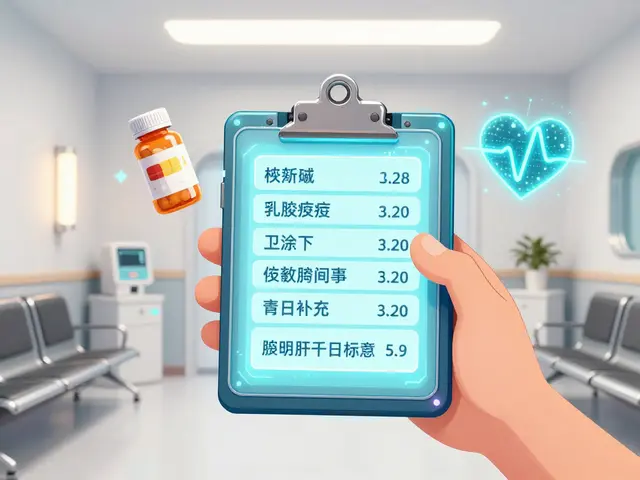
Contact Dermatitis Myth Quiz
Test your knowledge about contact dermatitis myths and facts!
1. Which of the following is NOT a cause of contact dermatitis?
2. What is the primary purpose of patch testing?
3. Which of the following is a recommended treatment for contact dermatitis?
4. Can contact dermatitis develop in adults even if it didn't occur in childhood?
5. What should you avoid doing when treating a contact dermatitis rash?
When your skin erupts with redness, itching, or blisters after touching something, contact dermatitis is an inflammatory skin condition caused by either an allergic or irritant reaction. Most people have heard the term, but far too many misunderstand what it really means, how it’s diagnosed, and what truly helps or hurts the skin. Below you’ll find the most common myths busted, practical steps to manage flare‑ups, and a quick‑reference chart to keep you on the right track.
Quick Takeaways
- Contact dermatitis is split into allergic and irritant types, each with distinct triggers.
- It’s not always caused by “allergies” - harsh chemicals or friction can be the culprit.
- Over‑washing or using strong soaps often worsens the condition.
- Patch testing is the gold‑standard for pinpointing the exact allergen.
- Gentle moisturizers and barrier repair creams are more effective than steroids for long‑term control.
What Exactly Is Contact Dermatitis?
Understanding the basics clears up a lot of the confusion. Allergic contact dermatitis (ACD) occurs when the immune system mistakenly identifies a harmless substance as dangerous and launches a delayed‑type hypersensitivity reaction. Common allergens include nickel, poison oak, fragrance mixes, and certain preservatives.
In contrast, irritant contact dermatitis (ICD) results from direct damage to the skin barrier (the outermost layer of the epidermis that protects against water loss and external aggressors) by chemicals, detergents, or even excessive friction. The reaction is immediate and does not involve the immune system.
Both forms share symptoms-redness, swelling, itching, and sometimes blistering-but the underlying cause dictates treatment and prevention.
Myth #1: “If I’m allergic, I’ll always react the same way.”
Many assume that a single exposure will produce the same severity every time. In reality, allergic reactions can vary based on the amount of allergen, skin condition, and even hormonal changes. A small amount of nickel in a watch strap might cause barely a patch of redness, while prolonged contact during a sweaty workout could trigger a full‑blown rash.
Understanding this variability helps you avoid unnecessary alarm and focus on pattern‑recognition rather than one‑off episodes.
Myth #2: “All skin rashes are allergic contact dermatitis.”
Skin rashes have a laundry list of causes-eczema, psoriasis, fungal infections, even viral exanthems. Assuming every itchy patch is contact dermatitis can delay proper treatment. For instance, atopic dermatitis (a chronic, genetically‑linked eczema that often co‑exists with allergies) frequently mimics contact dermatitis but requires different moisturising and anti‑inflammatory strategies.
Getting a professional assessment, especially if the rash persists beyond two weeks, is key.
Myth #3: “Washing the rash with antibacterial soap will cure it.”
While keeping the area clean prevents secondary infection, harsh soaps strip the skin’s natural lipid layer, worsening the barrier and prolonging healing. Look for fragrance‑free, pH‑balanced cleansers instead. Studies from Australian dermatology clinics show that gentle cleansing combined with immediate moisturisation reduces healing time by up to 30% compared with aggressive scrubbing.

Myth #4: “Topical steroids are the only effective treatment.”
Topical corticosteroids can calm inflammation quickly, but over‑use leads to skin thinning, stretch marks, and even systemic absorption. For mild to moderate flare‑ups, moisturizers (products that restore the skin’s lipid barrier and lock in hydration)-especially those containing ceramides, glycerin, or hyaluronic acid-are equally effective and safer for long‑term use.
Reserve steroids for severe or persistent cases, and always follow a tapering schedule prescribed by a dermatologist.
Myth #5: “If I avoid my known triggers, I’m safe forever.”
New sensitizations can develop over time. A person who never reacted to fragrance before may become allergic after years of low‑level exposure. Regular skin checks and, if you work in high‑risk environments (hairdressing, metalwork, healthcare), periodic patch testing (a diagnostic procedure where small amounts of potential allergens are applied to the skin under occlusion) can catch emerging sensitivities before they cause severe outbreaks.
How to Diagnose: The Role of Patch Testing
When the culprit isn’t obvious, a dermatologist will often perform patch testing. Small chambers containing standard allergens (the European baseline series, occupational series, etc.) are placed on the back for 48 hours. The skin is then evaluated at 48 and 72 hours for reactions. A positive result confirms a specific allergic trigger, allowing you to avoid it with confidence.
Patch testing is safe, minimally invasive, and the most reliable way to differentiate between allergic and irritant dermatitis.
Effective Management Strategies
- Identify the type: Use a doctor’s assessment or patch testing to know if you’re dealing with ACD or ICD.
- Protect the barrier: Apply a fragrance‑free moisturizer within three minutes of washing. Look for ingredients like ceramides, petrolatum, or urea.
- Choose gentle cleansers: Avoid antibacterial soaps, alcohol‑based wipes, and products with sodium lauryl sulfate.
- Use anti‑itch measures wisely: Cool compresses, colloidal oatmeal baths, or antihistamines can soothe symptoms without drying the skin.
- Limit steroid use: If a steroid is necessary, use the lowest potency for the shortest duration, then switch to moisturisers.
- Prevent recurrence: Wear protective gloves, use barrier creams, and keep a list of known allergens handy.
Prevention Tips for Everyday Life
- Inspect new jewelry for nickel content; opt for titanium or surgical‑grade stainless steel.
- When cleaning, wear nitrile gloves instead of latex, and change them frequently to avoid sweat buildup.
- Choose fragrance‑free personal care products; a quick scan of the ingredient list can save you weeks of irritation.
- Maintain a daily moisturising routine-morning and night-to keep the skin barrier robust.
- Schedule an annual dermatology check if you work in high‑exposure occupations.
Myths vs. Facts - Quick Reference Table
| Myth | Fact |
|---|---|
| All rashes are allergic reactions. | Rashes can stem from irritants, eczema, infections, or systemic issues. |
| Only allergens cause contact dermatitis. | Both allergens and irritants damage the skin, but via different mechanisms. |
| More soap equals faster healing. | Harsh soaps strip the barrier, slowing recovery; gentle cleansers are best. |
| Steroids are always required. | Moisturizers and barrier repair often suffice; steroids reserved for severe cases. |
| Once you avoid a trigger, you’re cured forever. | New sensitivities can develop; periodic reassessment is advisable. |

Frequently Asked Questions
Can I develop contact dermatitis as an adult if I never had it as a child?
Yes. Sensitisation can occur at any age. Repeated low‑level exposure to a new allergen, like a metal in a work badge, can trigger a reaction even if you were symptom‑free in youth.
Is patch testing painful?
Very little. Small adhesive patches are placed on the back; you may feel mild itching if you react, but the procedure itself is non‑invasive.
How long does it take for a rash to heal after I stop exposure?
Mild irritant dermatitis often clears within a week of avoidance and proper moisturising. Allergic cases may linger 2‑4 weeks, especially without barrier repair.
Can I use natural oils like coconut oil on a flare‑up?
Some people tolerate them, but coconut oil can be a mild irritant for sensitive skin. Opt for dermatologist‑recommended barrier creams that contain ceramides or petrolatum.
Are there any dietary changes that help?
Diet alone rarely cures contact dermatitis, but maintaining a balanced diet rich in omega‑3 fatty acids can support overall skin health and reduce inflammation.
Marsha Saminathan
Contact dermatitis is a skin condition that many people overlook. It happens when the skin comes into direct contact with an irritant or allergen. The immune system reacts and you see redness itching and sometimes blistering. Most people assume only chemicals cause it but natural substances like plants can trigger it too. Patch testing is the gold standard for identifying the exact culprit. Using gentle moisturizers helps restore the skin barrier and reduces flare ups. Over‑the‑counter steroid creams should only be used for short periods under doctor guidance. Frequent hand washing with harsh soaps actually worsens the condition. Avoiding known triggers is the most effective prevention strategy. Adults can develop new sensitivities even if they never had a rash as children. Genetics play a role but repeated exposure is often the main driver. Proper diagnosis can differentiate contact dermatitis from other rashes such as eczema or psoriasis. Treatment plans often combine avoidance, moisturization and occasional topical steroids. Education about product ingredients empowers patients to make safer choices. It is also useful to keep a symptom diary to track potential triggers. It is also useful to keep a symptom diary to track potential triggers. Lastly remember that healing takes time and patience so do not rush the process
Alice Settineri
I gotta be blunt you all love quizzes but rarely think about the real world impact of skin allergies and I’m here to spill the tea on how you might be ruining your own skin with everyday products thanks to that careless “just a little” attitude you keep bragging about
nathaniel stewart
I wholeheartedly commend the effort put into demystifying contact dermatitis it is indeed a commendable educational endeavor however please note that the term “definately” should be corrected to “definitely” and that a more rigorous citation of dermatological sources would further strengthen the discourse
Alex Jhonson
Hey everyone just wanted to add that when you’re picking moisturizers look for those labeled fragrance‑free and hypoallergenic because they tend to be gentler on compromised skin also remember that cultural practices can influence exposure so sharing your own experiences can help the community learn
Katheryn Cochrane
Honestly this post just rehashes basics that any dermatologist would tell you in a five minute consult
Michael Coakley
Oh great another “myth busting” quiz because what the world really needed was more pop‑science pop quizzes about itchy skin yeah right
ADETUNJI ADEPOJU
Utilizing a comprehensive allergen‑exposure matrix coupled with a stratified risk assessment protocol could ostensibly mitigate the prevalence of contact dermatitis incidents however one must acknowledge the inherently passive nature of such initiatives when they are merely touted as groundbreaking
Jim McDermott
Thanks for putting this together its really helpful i especially liked the part about how even adults can develop new sensitivities keep up the good work
Naomi Ho
Patch testing remains the most reliable method to pinpoint allergens and using emollient‑rich creams twice daily can significantly improve barrier function
Evelyn XCII
Sure patch testing is useful but let’s not pretend it’s a miracle cure for every rash because it’s not and that’s perfectly fine
Nina Vera
This quiz is literally the most thrilling thing I’ve seen all week
Christopher Stanford
While the info is solid it’s also pretty boring and could use a bit more excitement





Write a comment